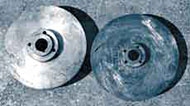
Worn parts help you part with your money
When you can find the time, it is wise to check the wear on all your farm machinery, including pumps.
Impeller wear
If the impeller is worn this can significantly increase your irrigation costs. Abrasive sand can wear the impeller, as can positioning the pump too high above the water source.
Why is this so?
When the pump is positioned too high, gas is drawn out of the water within the suction pipe, due to reduced pressure.
When the gas is subject to the high pressure within the pump it implodes and erodes small amounts of metal from the impeller.

A worn impeller can mean a poor distribution of water because it cannot transfer the power from the engine and so produces less pressure. (It acts like an impeller that is too small.) Once pressure falls, the water at the ‘business end’ of the irrigation system, the sprinkler heads, is not distributed in a uniform pattern. Often the farmer cannot detect this poor distribution by eye, although it can be measured.
'Poor distribution of water means you do not get optimal growth and yield across your whole crop,' irrigation officer Alan Richards explained. 'This ultimately affects your profitability.'
Testing the pump performance
To test how well your electric pump is working you can time the electricity meters and relate power consumption to water flow. A good result for your pump is between 200 and 300 kilowatt hours per megalitre pumped.
You can also calculate actual pump efficiency if you fit a pressure gauge to the pump delivery.
Does a worn pump always cost more?
Yes. Although pumping at a reduced pressure can save on hourly pump costs, it causes poor distribution. This reduces crop yield and quality, which will cost you far more.
Cost check
Generally pump running costs are around $25/ML for normal medium pressure sprinklers and $35/ML for high pressure (90 psi) sprinklers. But suppose your pump is damaged or worn: it could, for example, cost you an extra $10 per megalitre (ML) on top of these costs.
This means, if a replacement pump costs around $2000, pumping just 200 ML means you will have spent the cost of a new pump. (Two hundred megalitres is enough to irrigate about 35 hectares at 6 ML/ha for the season.)
In other words, if you were to irrigate forty hectares for more than one season with an inefficient pump, the extra energy it requires would cost you money.
Impeller troubleshooting
How else can an impeller cause pumping problems?
- No water or a reduced flow: stones may be blocking the impeller. (This can happen if the suction strainer is inadequate or rusted out; or if there is not enough surface area for the strainer to operate.)
- Reduced discharge pressure: impeller may be partially clogged or damaged, or it may be the wrong diameter.
Many other pump faults can cause these problems:
- blockages in the suction pipe or opening;
- air pocket or air leak in the suction line;
- speed too low;
- discharge head or suction lift too high;
- wrong direction of rotation;
- priming-casing and suction pipe not completely filled with water;
- mechanical defects;
- air leaking into the pump casing.

